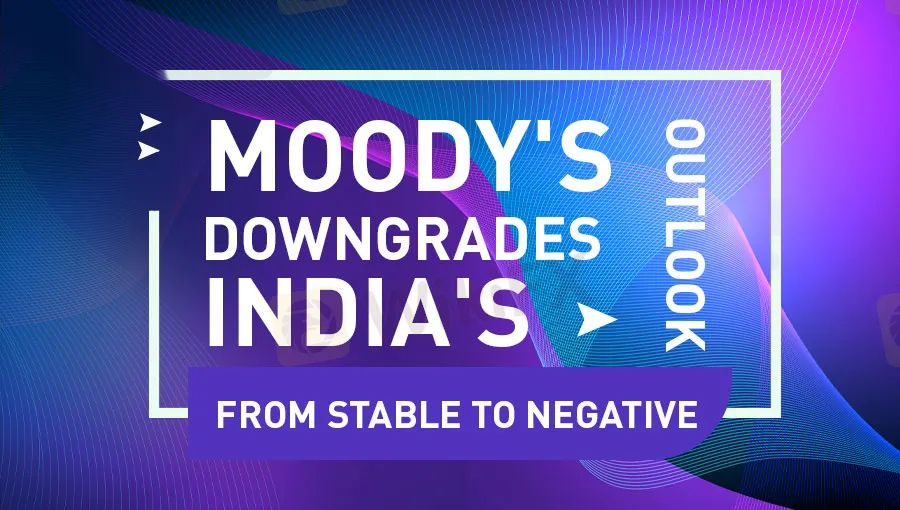简体中文
繁體中文
English
Pусский
日本語
ภาษาไทย
Tiếng Việt
Bahasa Indonesia
Español
हिन्दी
Filippiiniläinen
Français
Deutsch
Português
Türkçe
한국어
العربية
Moody’s Downgrades India’s Outlook from Stable to Negative
Abstract:Moody's Investors Service downgraded its outlook on India's ratings from “stable” to “negative”, citing rising risks to India's economic growth. Tumbling down to its lowest level in three weeks, the rupee fell as much as 0.5% against the US dollar to 71.31 at one point, the first decline in three weeks; the Indian stock market also dropped as the NSE index fell 0.4%.

Moody's Investors Service downgraded its outlook on India's ratings from “stable” to “negative”, citing rising risks to India's economic growth. Tumbling down to its lowest level in three weeks, the rupee fell as much as 0.5% against the US dollar to 71.31 at one point, the first decline in three weeks; the Indian stock market also dropped as the NSE index fell 0.4%. India‘s economic growth will still be significantly lower than in the past, which reflects to a certain extent that the government’s policy in addressing long-standing economic and institutional weaknesses is less effective than expected, and the situation can lead to a gradual rise in the already high level of debt burden.
In the first quarter of the fiscal year starting from April 1st, India's economic growth rate fell back to its lowest level in six years, as debt issues of banks curbed corporate and consumer spending in Asia's third-largest economy. In the three months ended June 30th, India's gross domestic product (GDP) growth fell to 5.0%. The data suggests that as the global economy shows a warning sign of a slowdown, India, which serves as a major engine for global economy, is also weakening.
Moody's observed that “Although the governments support for the economy should help reduce the depth and duration of India's slowdown, the ongoing financial pressure among rural households, weak employment creation, and recent credit crunch in non-bank financial institutions have all increased possibility of a more entrenched slowdown in the Indian economy.” The rating agency said that unless reforms are introduced to directly reduce barriers on labor and land productivity, stimulate private sector investment and continue to strengthen the financial sector, potential GDP growth and job creation opportunities will still be restricted.
“Without such reforms, structural constraints on productivity and job creation will weigh further on Indias sovereign credit profile.” Moody's confirmed India's Baa2 foreign currency and local currency long-term issuer rating, and confirmed India's Baa2 local currency priority unsecured rating. In Moody's rating system, Baa2 is a mediocre rating, indicating a moderate credit risk.

Disclaimer:
The views in this article only represent the author's personal views, and do not constitute investment advice on this platform. This platform does not guarantee the accuracy, completeness and timeliness of the information in the article, and will not be liable for any loss caused by the use of or reliance on the information in the article.
Read more

Keep Silence to FX Scams? NO! EXPOSE Them on WikiFX!
Keep Silence to FX Scams? NO! EXPOSE Them on WikiFX!

Watch out! PlatformsFx Robbed Me of US$76,878
A few months ago, a person from the trading solution provider company “PlatformsFx” contacted the victim for forex trading. According to the victim, the scammer and his so-called well-known gold trading platform took US$76,878 from her and put it into a presumably real forex account.

How to choose the best leverage level
Archimendes said: “Give me a fulcrum, I can lift the whole earth”. This is the earliest appearance of the concept of leverage. The word leverage dates from 1724 and was originally used to describe the action of a lever. By 1824, by which time the Industrial Revolution was fully underway, the scope of the word had expanded to include the power of a lever and therefore the obtaining of a mechanical advantage. It is simple to say that if you want to invest $10,000 in the forex market, you can to it by leverage with small investment. Leverage is a financial tool, which can magnify the result of your investment, including gain or loss at a fixed ratio.

Oil Prices Hit Fresh High on Uncertain Outlook
WikiFX News (6 Aug) - WTI crude oil embraced a steep rise in prices, up 4.5% to the high level of $43.68, compared to its low level of $41.76. It has recorded a fresh five-month high since March 6. Nevertheless, the outlook of oil remains uncertain because of the insufficient upward momentum in future oil prices resulted from the sluggish job growth in the United States.
WikiFX Broker
Latest News
JUST Finance and UBX Launch Multi-Currency Stablecoin Exchange
XM Revamps Website with Sleek Design and App Focus
Global Shift in Cryptocurrency Taxation: Italy and Denmark Chart New Paths
Webull Introduces 24/5 Overnight Trading to Extend U.S. Market Access
TradingView & Mexico’s Uni. Partnership, to Enhance Financial Education
Something You Need to Know About SogoTrade
eToro Launches Global-Edge Smart Portfolio: A Balanced Approach to Growth and Stability
Darwinex advises traders to update MT4 & 5
Revolut X Expands Crypto Exchange Across Europe, Targeting Pro Traders
Broker Review: Is Exnova Legit?
Currency Calculator


